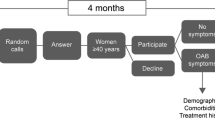Abstract
The aim of this study was to evaluate the prevalence and awareness of symptoms suggestive of underactive bladder (UAB) in a heterogeneous, non-specific population to garner additional epidemiologic information about UAB. After IRB approval, an 18-item survey was mailed to 5,000 people living in metro Detroit to collect demographic data and questions regarding clinical urinary symptoms and familiarity with UAB. A total of 633 subjects (13; 54 % men, 46 % women) returned the survey. Nearly one quarter (23 %, n = 137) of respondents reported difficulty emptying his/her bladder, yet only 11 % (n = 70) had ever heard of UAB. The study results indicated that patient-reported bladder emptying symptoms are prevalent, as common in women as men, and significantly associated with comorbidity and poor self-reported health. The results suggest that the burden and impact of UAB might be significant and that a syndromic concept of UAB warrants research to determine the true burden of disease, increase awareness, and broaden efforts to investigate therapeutic directions.

Similar content being viewed by others
Abbreviations
- BOO:
-
Bladder outlet obstruction
- DESx:
-
Difficulty emptying bladder symptoms
- DU:
-
Detrusor underactivity
- ICS:
-
International Continence Society
- IDC:
-
Impaired detrusor contractility
- LUTS:
-
Lower urinary tract symptoms
- UAB:
-
Underactive bladder
- UAB-q:
-
Underactive bladder questionnaire
References
Abrams P, Cardozo L, Fall M, Griffiths D, Rosier P, Ulmsten U, van Kerrebroeck P, Victor A, Wein A, Standardisation Sub-committee of the International Continence S (2002) The standardisation of terminology of lower urinary tract function: report from the Standardisation Sub-committee of the International Continence Society. Neurourol Urodyn 21(2):167–178
Dubeau CE (2006) The aging lower urinary tract. J Urol 175(3 Pt 2):S11–S15. doi:10.1016/S0022-5347(05)00311-3
Howden LM, Meyer JA (2011) Age and sex composition: 2010. United States Census Bureau. http://www.census.gov/prod/cen2010/briefs/c2010br-03.pdf
Nuotio M, Tammela TL, Luukkaala T, Jylha M (2003) Predictors of institutionalization in an older population during a 13-year period: the effect of urge incontinence. J Gerontol A Biol Sci Med Sci 58(8):756–762
Miyazato M, Yoshimura N, Chancellor MB (2013) The other bladder syndrome: underactive bladder. Rev Urol 15(1):11–22
Jeong SJ, Kim HJ, Lee YJ, Lee JK, Lee BK, Choo YM, Oh JJ, Lee SC, Jeong CW, Yoon CY, Hong SK, Byun SS, Lee SE (2012) Prevalence and clinical features of detrusor underactivity among elderly with lower urinary tract symptoms: a comparison between men and women. Korean J Urol 53(5):342–348. doi:10.4111/kju.2012.53.5.342
Abarbanel J, Marcus EL (2007) Impaired detrusor contractility in community-dwelling elderly presenting with lower urinary tract symptoms. Urology 69(3):436–440. doi:10.1016/j.urology.2006.11.019
Taylor JA 3rd, Kuchel GA (2006) Detrusor underactivity: clinical features and pathogenesis of an underdiagnosed geriatric condition. J Am Geriatr Soc 54(12):1920–1932. doi:10.1111/j.1532-5415.2006.00917.x
Osman NI, Chapple CR, Abrams P, Dmochowski R, Haab F, Nitti V, Koelbl H, van Kerrebroeck P, Wein AJ (2014) Detrusor underactivity and the underactive bladder: a new clinical entity? A review of current terminology, definitions, epidemiology, aetiology, and diagnosis. Eur Urol 65(2):389–398. doi:10.1016/j.eururo.2013.10.015
Acknowledgments
Funding for this conference was made possible (in part) by 1R13AG047010 from the National Institute on Aging. The views expressed in written conference materials or publications and by speakers and moderators do not necessarily reflect the official policies of the NIH; nor does mention by trade names, commercial practices, or organizations imply endorsement by the US Government.
Conflict of interest
Michael B Chancellor has conflicts of interest related to Allergan, Astellas, Cook, Lipella, Medtronic, Pfizer, Targacept. There are no conflicts of interest for Sara Valente, Catherine DuBeau, David Chancellor, Justin Okonski, Andrew Vereecke, Florence Doo, Michelle Lajiness, and Ananias Diokno.
Author information
Authors and Affiliations
Corresponding author
Rights and permissions
About this article
Cite this article
Valente, S., DuBeau, C., Chancellor, D. et al. Epidemiology and demographics of the underactive bladder: a cross-sectional survey. Int Urol Nephrol 46 (Suppl 1), 7–10 (2014). https://doi.org/10.1007/s11255-014-0811-1
Received:
Accepted:
Published:
Issue Date:
DOI: https://doi.org/10.1007/s11255-014-0811-1




